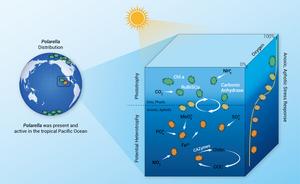image:
Polarella has only been isolated from polar regions, though through -omics techniques, we have been able to identify the genera in a tropical oxygen deficient zone. Our data suggests that as oxygen and light declines, Polarella shifts from a phototrophic lifestyle (green) to potential heterotrophy (orange). At depths where oxygen is depleted and light level extremely low, Polarella upregulates genes involved in the uptake of both inorganic and organic nutrients and stress response.
view more
Credit: Birch Maxwell Lazo-Murphy designed the concept image and was finalized by the OLAR editorial office/graphic design team
A tiny single-celled organism may have a big impact on how the world’s basic chemical building blocks cycle between living things and the non-living environment. Called Polarella, the algal genus was thought to be restricted to polar cap regions of Earth, but a team has revealed that it is abundant and influential in the Eastern Tropical North Pacific Ocean off the coast of Mexico.
The researchers, based at the University of South Carolina (USC), published their findings on May 26 in Ocean-Land-Atmosphere Research.
Polarella is a type of dinoflagellate that makes up a major portion of marine microbial communities and contributes significantly to global primary production, said first author Birch Maxwell Lazo-Murphy, a graduate student pursuing a Ph.D. in marine science in the laboratory of Xuefeng “Nick” Peng, the corresponding author and an assistant professor of in USC’s School of Earth, Ocean, and Environment.
“Understanding the roles of free-living dinoflagellates — as opposed to those that live in symbiosis with other organisms — in dynamic environments is critical, as these habitats often harbor high microbial diversity and niche differentiation,” Lazo-Murphy said. “Gaining a deeper insight into these environments will enable more accurate predictions of how these globally important groups will respond to environmental changes.”
One such dynamic environment in marine systems are oxygen-deficient zones (ODZs), where oxygen levels are so depleted that oxygen often can’t be detected even by state-of-the-art sensors. This results from a process called remineralization, which involves living matter decaying into its basic chemical building blocks. According to Lazo-Murphy and Peng, these zones account for less than 1% of the ocean area on Earth, yet they are responsible for losing 33% of biologically available nitrogen — which is critical for plant growth, human health and more — across the globe.
“ODZs have been expanding in size in part due to anthropogenic warming, so the role of ODZs and their respective microbial communities in global nutrient cycling is becoming increasingly important,” Peng said.
To better understand the specific microbial communities in these areas, including how they respond to change and potentially impact nutrient cycling, the researchers used a technique called metatranscriptomics. They collected seawater samples from the oxygen-rich surface, mid-depths and oxygen-depleted depths of the Eastern Tropical North Pacific Ocean, which houses the world’s largest ODZ. They extracted and sequenced genetic material, from which they identified the specific organisms present in each sample.
“We found unexpectedly high relative contribution of Polarella, which is thought to have bipolar distribution, to the microbial communities in the Eastern Tropical North Pacific Ocean,” Lazo-Murphy said. “Once we established their abundance, we set out to understand the functions and gene expressions of Polarella, as well as their impacts on the nutrient cycles, in the ODZ.”
Further analysis revealed increased expression of stress response genes in Polarella, ranging from the lowest stress in surface samples to the highest in samples from oxygen-depleted depths. The researchers also found that the closer to the surface, genes for photosynthesis — converting sunlight into energy — were more highly expressed. In addition, they found that, while the overall gene expression was low for Polarella from low-oxygen or oxygen-free areas, the genes involved in transporting organic and inorganic nutrients were more highly expressed. Lazo-Murphy said this suggests that Polarella has an opportunistic lifestyle, taking advantage of available resources wherever it exists.
“Collectively, these findings suggest that Polarella thrives beyond polar regions and likely plays a more significant ecological and biogeochemical role in the ocean than previously recognized,” Lazo-Murphy said.
The Simons Foundation Postdoctoral Fellowship in Marine Microbiology and the Simons Early Career Investigator in Aquatic Microbial Ecology and Evolution Award to Peng supported this research.
Journal
Ocean-Land-Atmosphere Research
Method of Research
Data/statistical analysis
Article Title
Unexpected Abundance and Gene Expression of Polarella from a Tropical Oxygen Deficient Zone
Article Publication Date
17-Jun-2025
COI Statement
There are no conflicts of interest to declare.
Disclaimer: AAAS and EurekAlert! are not responsible for the accuracy of news releases posted to EurekAlert! by contributing institutions or for the use of any information through the EurekAlert system.
